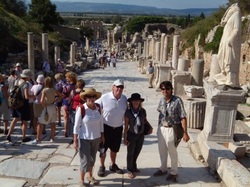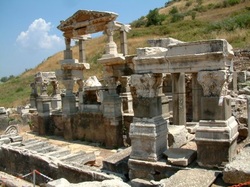Hercules GateThe Gate was built in the form of a triumphal arch towards the second half of 4th century. The gate is named after Hercules due to the reliefs represting Hercules
wearing lion's skin. The gate was made narrow to prevent wheeled vehicles like chariots which came from the Magnesian Gate going into the city. In mythology, Hercules was a god the son of Zeus who had a half divine nature and half human nature. He was the god of agriculture, the protector of soil and honest business. Strongest human. After the gates travellers start walking through shops and residential areas. Since the chariots were not allowed to pass through, the streets after gate of Hercules are much smoother. Curetes Street Curetes Street Ephesus
The Curetes Street lies between the Hercules Gate and the Celsus Library. Some name lists of the Curetes were inscribed on marble columns found on the north side of the street. The modern name of the street derives from these inscriptions. Curetes were priests of Artemis who were believed to help Artemis with new births. According to some historians, there is a high possibility of the French word Curetage for abortion is originated from the Curetes of Ephesus. They used to serve in the Prythenion. In literary sources the street was called Embolos. The street was decorated by statues, wealthy homes, posh stores, memorials, temples, fountains, porticos.. Only statue remained is the statue of a doctor called Alexanderos who probably served in the hospital of Ephesus.
Trajan Fountain Trajan Fountain Ephesus
Fountain of Trajan is a 2nd century AD building with two stories built by an Ephesian in memory of the Emperor Trajan. Trajan was the Roman Emperor who ruled Roman Empire in the 2nd century. In his time Roman Empire was in its peak time. In front of the building there was a pool with water flowing from beneath the colossal statue of Trajan. Trajan was depicted as left foot on the ground, right foot on a ball. Saying "I am the ruler of the world. The world is under my foot." Left foot of his statue can still be seen today. The ball under the foot symbolizing the world. In the 17th century Galilieo period, Europe was not sure if the world had a round shape. Galileo was banned because of his ideas. Aristotales knew that the world had sphere shape in 225BC. During that time Erathostenes calculated the diameter of the World. Philosopher Thales calulated Solar eclipse in 585BC, probably he knew that the world was round too. Statues of other emperors, gods and heroes stood in niches. Some of these are displayed in the museum today. The facade of the building is highly ornate with Corinthian columns on the upper storey and Composite columns on the lower. Composite colums were a combination of Ionic and Corinthian colums. Very popular in the 2nd century.
Temple of HadrianThe Hadrian Temple was built in the 2nd century AD and renovated in the 4the century AD in the name of the Emperor Hadrian. Hadrian was the Roman Emperor who ordered the walls between Scotland & England. He came to rule after Trajan. It was originally in Corinthian style consisting of a cella and a porch. The keystone of the arch has a relief of Tyche (Romans called her Fortuna), the goddess of fortune & destiny. In the lunette over the entrance to the cella, there is another relief of a semi-nude girl, probably of Medusa, in acanthus leaves. Medusa is a protective architectural element for evil. According to the mythological story Medusa was a gorgeus girl who took the attention of Zeus. His jealous wife turned her into a giant with snake hair and who ever she looked the person was turning into a stone. Athena, the godess of wisdom wanted the head of Medusa. She assigned Perseus. Perseus had the head cut off. While he was transporting the head to Athena from each blood drop snakes in the world was created. Athena used the head on her shield to be protected from her enemies. This became a tradition in Roman Buildings and Roman shields. Today we do have a very similar faith. Once we purchase a property or a car or once we have new baby, we always have an evil eye on. To keep the bad spirits away, protection against earthquakes, eyes of jealousy, accidents... Friezes were added there from different places in Ephesus during a restoration in the 4th century AD. They are scenes relating to the legendary foundation of the city. From left to right: Androclus, the mythological founder of the city, killing a wild boar. and battle with Amazons can be seen. On the facade meander motives with sevastika (German cross) is taking attention.
|
|


